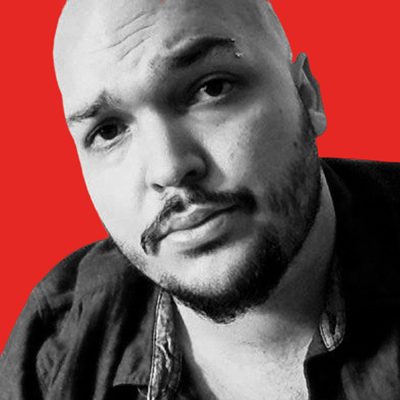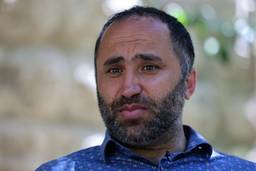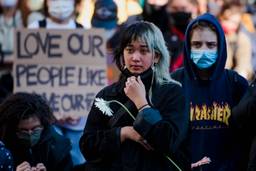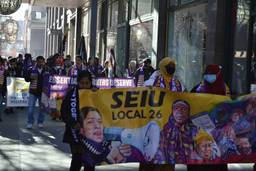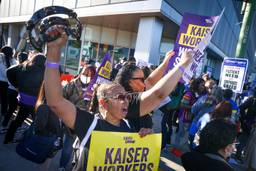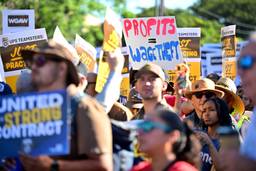What It's Like Being a Gravedigger During the Pandemic
A conversation with a cemetery worker about politics, life and labor during the Covid crisis.
Maximillian Alvarez
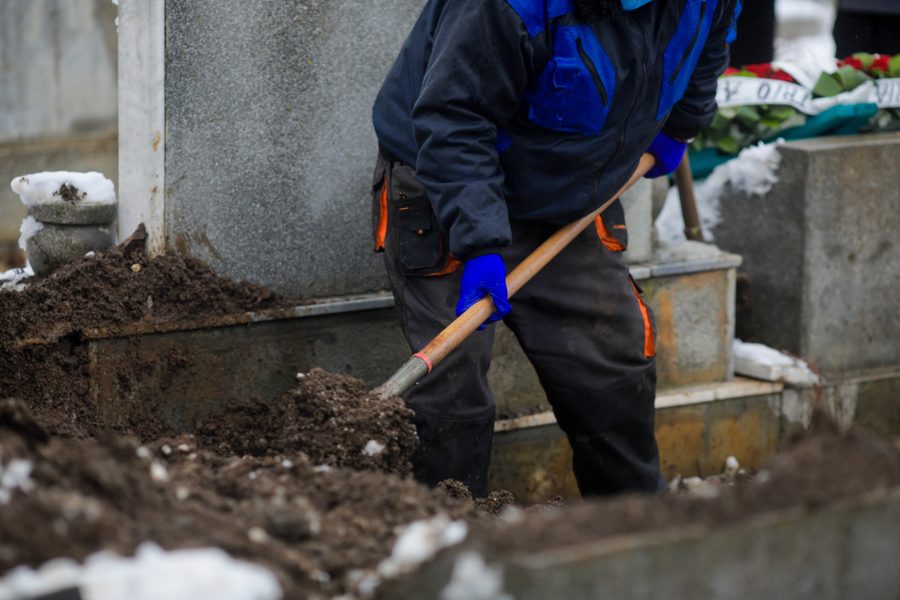
The following interview is excerpted from Maximillian Alvarez’s The Work of Living: Working People Talk About Their Lives and the Year the World Broke (2022) with the permission of OR Books. For a limited time, In These Times readers can get 15% off The Work of Living with the code ITT15.
Nick Galuppo: My name is Nick. I reside in central-northern New Jersey — it used to be a smaller suburb, but I guess you could say things have picked up in terms of speed and people. I’m thirty-eight years old. Been working in a cemetery almost two decades now.
When I was eighteen, I was working at a seasonal job unloading trucks and got laid off. Now, my father was a union carpenter, as was his older brother, and his father before him. I figured I’d go into the construction outfit as a laborer, maybe like a journeyman or something. But I seen how my father lived — he was laid off a lot, he was traveling all over the place — and I didn’t like that inconsistency of work, you know? So, I kind of had… I guess you could say I had a bit of reluctance about it.
And one night, he was at the Knights of Columbus talking to a friend. He said, “Hey, my son’s looking for work. If anybody hears anything, knows anything, keep your ears open.” And one guy there responded and said, “Hey, I’m a regional manager for seven cemeteries,” and these were cemeteries from North Jersey, South Jersey, Delaware, Rhode Island — like, over three different states. He said, “The work’s hard, the work’s messy, but if the kid don’t mind working, we’ll give him a shot.”
So, I got the job. This was in 2001 – 2002. When I started, I was put on a ninety-day probationary period. I was only told I’d be staying-on on my eighty-ninth day — this was on Christmas Eve, about five minutes before quitting time…
Maximillian Alvarez: [Laughs.]
Nick: The manager was… everything you’d expect him to be. He was a ruthless little guy. Little in every sense of the word: morally, physically, mentally. He was a little egomaniac. But what are you gonna do? He was a boss, he was strict, etc., and that’s fine.
So, like I said, I got the job. And I’m nineteen years old at the time — very wet behind the ears. And, shit, at that point, I wasn’t even really driving much. I didn’t have a lot of money then, and car insurance is expensive. But it was around that time I got my first vehicle and started working in the cemetery. It was nothing like I thought it was gonna be. I was told it was like a landscaping job — you know, “You’re gonna cut grass, you’re gonna rake leaves.” Like some sort of a Parks Department gig. Couldn’t be farther from the truth… It’s a death factory. It’s busy, like a construction site. It’s like a fast-paced construction site… for the dead.
As far as the places that I work in — there’s three cemeteries in a small area. We’re responsible for two of them, as per the contract that we just negotiated. So, we got the two of them. One is a mainly Jewish cemetery, close to three hundred acres in size, which does about 1,500 burials a year. It’s open seven days a week. And, you know… it really is wild. You got so many different elements that come into play that make the job different from the aforementioned construction site. With construction, you got mom-and-pop shops or you got commercial construction. But either way, you’ve still got some oversight: You have state laws, federal guidelines, you have OSHA [Occupational Safety and Health Administration], you have all these different levels of bureaucracy and regulation.
It’s different in the cemetery, though. The cemetery is kind of like everybody’s best-kept secret. Everybody knows that you die. But nobody really understands what happens when you die or how that process comes to be.
Now, that process can vary based on your religion, based on how you want to get buried, or interred, or entombed, or cremated. Things can vary quite a bit. But in my experience, which is almost two decades in a high volume location, what’s known as a “Tier One” location, when you take the geography of where I work, the varying soil content, the manner in which people are buried, the water table — you mix all that up with how many people get buried in such a tight area, it’s a recipe for chaos.
People might think, “Oh, you work in a cemetery? You must be coming out with a lantern and a shovel at midnight to bury somebody peace fully on a hill, under the moonlight.” Yeah, it’s not like that at all. It’s, um, it’s pretty wild.
…Maximillian: It’s been a long, arduous, and intense road through this pandemic, and I think most people can’t even imagine what it’s been like for you and your coworkers. Can we talk about that a bit? Try to put us back in your shoes and see if you can recall what it was like for you — at your job, but also just as a person on this earth, in this country — as the reality of Covid-19 started to set in.
Nick: For me, when Covid-19 hit the news — I guess it was around January of last year — I was like, “Eh.” I was a little bit jaded, I guess. I said, “Nah, not here. This is America,” you know? “We’re exempt from stuff like this, we’re unaffected, because we’re the greatest country in the world. No dice, not happening here, not on our watch.”
Then a couple of months went by and it just wasn’t going away. People kept talking about it, and it just got bigger and bigger. Every major news channel was talking about it, then they started talking about wearing masks and this and that. I was like, “What? Are you kidding me?” I think what changed it for me — what made “Covid-19” go from just being a name to being something tangible and real — was when I talked to a buddy of mine in the restaurant business. He’s been a manager for a chain of restaurants for over twenty-some-odd years and then, boom, very early on, the restaurants went out of business. It happened so fast, like at the drop of a hat. That made me start thinking about the economic impact of the virus.
Then, last year — from, like, April, to May, to June — that’s something I’ll never forget. And it’s that experience, in those three months, that makes me question this whole entire Covid-19 thing. I’ll elaborate.
Again, there are three cemeteries in my area. At the one where I work, we do an average number of burials daily. The total number of burials we do each year never deviates by more than, like, 50 to 150. At the end of the year, we’re always right around the average number, and there’s an average number we do on a given day. But in April, May, and June, for three months, we were burying and entombing between ten and fifteen people a day, every day. It was like nothing I’ve ever experienced in my life. I mean, eight or nine jobs a day: that maybe happens, like, four or five times a year; maybe a dozen at most. But we were doing more than that every day for ninety days. It was crazy. So, I’m thinking to myself, “Wow, everybody’s getting infected, and everybody who’s getting infected is perishing. This is just nuts!”
But here’s the thing, Max. All of a sudden, well, not all of a sudden, but at the end of this three-month period, we go from ten, twelve, fifteen burials a day to, like, five, six, five, five, four, three, five, three, three, one. It just slid right back to normalcy. So, when the news is covering it now, whether it’s a Republican news channel or a Democratic news channel and, you know, when it comes to covering real things, when it comes to stuff that affects Americans, news should be the same. Unfortunately, with all the politics, it’s not. But anyway, the news is covering it, and they’re showing us numbers of deaths and this and that, and I gotta be honest: I’m not experiencing what the media is covering in the cemeteries anymore. Now, are we getting people who died of Covid-19? Supposedly, yes. What I mean by that is: I’m not denying that they died of Covid-19. They very well could have, but this is verbal information that directors are communicating to the cemetery: “Hey, just to let you guys know: This person died of Covid-19.” That’s what they’re saying. Whether they actually died from it, I don’t know. Whether it was written on their death certificate, I don’t know. I don’t want to go too far down that rabbit hole, but my point is that when they talk about this thing spiking and getting really bad again, I don’t experience it. It doesn’t carry over into the cemeteries. So, I question it. I have no choice but to question it.
But I cannot argue with what I experienced for those three months, man. I gotta tell you, just to keep it raw and real: You’d get into work, you’d start at seven-ish, 7:30 a.m., and you’d leave at 5:30 p.m. There were no piss breaks. If you were driving for, like, thirty seconds from one location to the next and you could chug some water in the truck, good for you. If not, you were just S.O.L (Shit Outta Luck). It was insane. We had to put courtesy to the side, cause we were just running through the cemetery, opening up a hole, putting people in the ground and burying them. Just no grace whatsoever. And I’m not being dramatic about that. I just can’t explain how busy it was. If there’s five burials in the location on one day, you’re gonna consolidate ten hours’ worth of work into an eight-hour day. When there’s twelve to fifteen people getting buried, you’re consolidating twenty hours of labor into an eight-to-ten-hour period.
Maximillian: Jesus. And that’s all on top of the conditions you already talked about, right? Everything is already so tightly packed and the soil conditions vary so much that you’re having to put metal bars in the ground so the remains in neighboring graves don’t roll into the hole for the person being buried now. I can only imagine what that was like when you’re trying to bury fifteen people in a single day!
Nick: Yeah, there’s just a lot of shortcuts, man. I mean, management’s not going to write it down and spell it out for you, but they’re gonna tell you, “We can’t worry about that thing; we just gotta do this, gotta do that.” A lot of preventative measures we normally take just went out the window. It was the bare minimum, literally. That translated to cosmetic application: Instead of looking clean and professionally done, it looked like a bomb went off in the area. It also translated to other things. With the water tables, for instance, we usually pump graves with Honda engines and four inch hoses — that got put to the side. A lot of things got put to the side so that we could, at the very least, provide a resting place that day for that individual and for their family.
We were supposedly given government mandates to stay open later so we could accommodate more interments. But the weird thing for me — and maybe I’m just wrong, maybe I’m just ignorant, it’s very possible. What I don’t understand is they talk about how Covid-19 is more contagious and more people are passing, but we’re not experiencing that in the cemeteries. Just to be clear, there’s three cemetery locations here in a three mile perimeter: one’s 260 acres, one’s 88 acres, one’s 48. The 48-acre place is Catholics. The 88-acre place is Chinese, Jewish, and Catholic. And then the other place, the big place, is 90 percent Jewish and probably 10 percent non-sectarian; Catholic, Christian, etc. While they’re claiming that so many people are passing away from the virus, we’re just not seeing that anymore — it’s not like it was in the cemetery back in the spring. When it was really bad, and we had these spikes, man, we were crazy for those three months. Now, it’s back to normal.
For me, I’m saying to myself, “This is where I work, this is what it is. If I get it, I get it.” I can’t prevent it, you know? I can’t prevent it. You put a mask on, sure, but you’re sweating and sweating — even in the winter, sweating, shoveling, breathing, you gotta touch your face and your hands are full of mud and whatever else. There’s just no way. Think about why people wear masks: They wear them so they don’t get contact-trace amounts of bacteria or pathogens in their body. Then think about being on a construction site where you’re rushing to put people in the ground — just try to remain sanitary in regards to your hands, or mask, or face. I mean, I got lowering devices that weigh eighty-five pounds, I got monuments, four-way cables, center straps, shale bars, brace boards, brace bars, the back hoe, there’s lids, straps, lid cables — there’s just so many different things that I’m in contact with.
There’s no way for me to prevent coming into contact with an aerosolized virus that comes out of people’s lungs. And in our place, my company doesn’t want to put anything down on paper or say to people, “Due to Covid-19, we’re gonna do this to keep our people safe.” For example, at other locations, families aren’t even allowed into the cemetery. But us? We take all comers. The governor may put a mandate out that only fifty people are allowed to congregate, but we got three hundred people at the gravesite. So, what we’ll do is we’ll tell the family, “Hey, stay in your cars, let us lower the casket, and then you can come over and have your service. Then, when you want to see it backfilled, you gotta go back to your vehicles.” That’s a hard pill to swallow for certain people because they want to be there for all of that. I would say that our policies are extremely lax, especially compared to other places. Is that dangerous? Is that good? Is it bad? I don’t know.

I hope you found this article important. Before you leave, I want to ask you to consider supporting our work with a donation. In These Times needs readers like you to help sustain our mission. We don’t depend on—or want—corporate advertising or deep-pocketed billionaires to fund our journalism. We’re supported by you, the reader, so we can focus on covering the issues that matter most to the progressive movement without fear or compromise.
Our work isn’t hidden behind a paywall because of people like you who support our journalism. We want to keep it that way. If you value the work we do and the movements we cover, please consider donating to In These Times.
Maximillian Alvarez is editor-in-chief at the Real News Network and host of the podcast Working People, available at InTheseTimes.com. He is also the author of The Work of Living: Working People Talk About Their Lives and the Year the World Broke.
